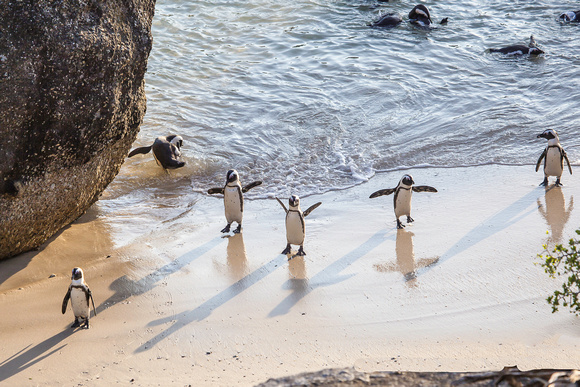African Penguin (Spheniscus demersus)
African Penguin (Spheniscus demersus)
23 inches long
Also known as the jackass penguin and black-footed penguin, it is a species of penguin, confined to southern African waters.
Widely known as the "jackass" penguin for its donkey-like bray, although several related species of South American penguins produce the same sound.
It is flightless, with a streamlined body, and wings stiffened and flattened into flippers for a marine habitat. Adults weigh on average 4.9–7.7 lb and are 24–28 in tall. It has distinctive pink patches of skin above the eyes and a black facial mask; the body upperparts are black and sharply delineated from the white underparts, which are spotted and marked with a black band.
The pink gland above their eyes helps the penguins to cope with changing temperatures. When the temperature gets hotter, the body of the African penguin sends more blood to these glands to be cooled by the air surrounding it. This then causes the gland to turn a darker shade of pink.
The African penguin is a pursuit diver and feeds primarily on fish and squid. African penguins forage in the open sea, where they pursue pelagic fish such as pilchards and anchovies (e.g. Engraulis capensis),[14] and marine invertebrates such as squid and small crustaceans. Penguins normally swim within 12 miles of the shore. A penguin may consume up to 1 pound of prey every day, but this may increase to over 2 pounds when raising older chicks.
The African penguin is monogamous. It breeds in colonies, and pairs return to the same site each year. The African penguin has an extended breeding season, with nesting usually peaking from March to May in South Africa, and November and December in Namibia. A clutch of two eggs are laid either in burrows dug in guano, or scrapes in the sand under boulders or bushes. Incubation is undertaken equally by both parents for about 40 days. At least one parent guards the chicks until about 30 days, whereafter the chick joins a crèche with other chicks, and both parents head out to sea to forage each day.
Chicks fledge at 60 to 130 days, the timing depending on environmental factors such as quality and availability of food. The fledged chick then go to sea on their own and return to their natal colony after a lengthy time period of 12–22 months to molt into adult plumage.
Their distinctive black and white colouring is a vital form of camouflage called countershading– white for underwater predators looking upwards and black for predators looking down onto the dark water.
Roughly 4 million penguins existed at the beginning of the 19th century. Of the 1.5-million population of African penguins estimated in 1910, only some 10% remained at the end of the 20th century. African penguin populations, which breed in Namibia and South Africa, have declined by 95 percent since pre-industrial times.
The total population fell to 200,000 in 2000. In 2010, the number was estimated to be only at 55,000. If this decline is not halted, the African penguin is expected to be extinct within 15 years.


